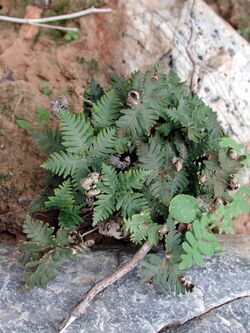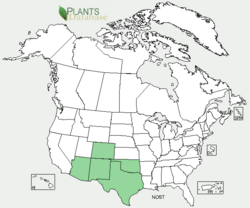Biology:Notholaena standleyi
| Notholaena standleyi | |
|---|---|

| |
| Notholaena standleyi. Standley's cloak fern from Phoenix Mountains Preserve, Maricopa County, Arizona, USA. | |
| Scientific classification | |
| Kingdom: | Plantae |
| Clade: | Tracheophytes |
| Division: | Polypodiophyta |
| Class: | Polypodiopsida |
| Order: | Polypodiales |
| Family: | Pteridaceae |
| Genus: | Notholaena |
| Species: | N. standleyi
|
| Binomial name | |
| Notholaena standleyi Maxon
| |
Notholaena standleyi, also known as star cloak fern and Standley's cloak fern, is a fern that is native to the United States and Mexico. It is a member of the genus Notholaena, which is part of the subfamily Cheilanthoideae of family Pteridaceae. It is distinguished by the pentagonal shape formed by the blades of its frond, a property other members of Notholaena do not possess.
Taxonomy
Notholaena standleyi was named after Paul C. Standley, Assistant Curator of the United States National Herbarium, who studied plants in southwestern United States. First described as Notholaena candida var. quinquefidopalmata in 1864, it was elevated to a species as Notholaena hookeri in 1879 by D. C. Eaton. However, this name had already been used to describe another fern, and it was renamed by William R. Maxon in 1915. He named it after Standley, who had engaged in a great deal of field study in the southwestern United States. Standley was also collaborating with E. O. Wooton to develop a comprehensive Flora of New Mexico at the time.[1]
Distribution
Notholaena standleyi is indigenous to southwestern United States and parts of north and central Mexico. It specifically grows in Arizona, Colorado, New Mexico, Oklahoma, and Texas in the USA.[2]
Habitat and Ecology
Notholaena standleyi is a perennial species that typically grows in desert regions at elevations from 300 to 2100 m.[3] It is found on rocky hillsides, usually in the crevices created by limestone and granite boulders that provide the partial shade the plant prefers. During periods of drought, the frond may curl and become brown until water is available, an adaptation to the semi-arid environments it inhabits.[4] At lower elevations, it sometimes grows alongside Notholaena californica.[5]
It takes 13 days to germinate and sporulates from late spring to fall.[3] It has the same life cycle as a typical fern, the sporophyte produces haploid spores by meiosis, which grows into a haploid gametophyte. The gametophyte produce gametes by mitosis. The fertilized egg when develop into the sporophyte by mitosis. The spore is transported by air and water.
Morphology
Individuals of this species have brown petioles and green fronds. The ferns are erect and grow to a height of 25 centimetres (9.8 in). The petioles grow to a length of 5 to 13 centimetres (2.0 to 5.1 in). The individual fronds are usually 3 to 7 centimetres (1.2 to 2.8 in) wide as well as long.[5] The frond is light green when young, becoming darker green as it matures, and usually contains five blades arranged in a pentagonal fashion. The blades are bipinnately or tripinnately compound, and each of them is triangular and pointed. The abaxial side of the frond is covered by powdery farina, with a function that is still unclear.[6] The color of the farina differs between species growing in different geographic locations. These are referred to as chemotypes, of which there are four. These chemotypes also have different number of complete chromosome sets. Gold and yellow farina are diploids, pallid and yellow/green are tetraploids.[7]
Its prothallus contains glandular trichomes. It usually has 32 spores per sporangium, but many with only 16 have been observed, produced from eight 2n mother cells.[8] It is diploid and has 60 chromosomes in its root tip cells.[9]
Usage
The Seri Indians made tea from the fronds to promote fertility in women. The species was also believed to have supernatural value; the Seri carried in a small cloth bag to bring good luck to the bearer.[4] It has been studied in potential herpes treatments, because of its antiviral activity. Notholaenic acid, isolated from the species, has shown anti-HSV-1 activity at high concentrations (25 μg/disk).[10]
References
- ↑ Maxon, William R. (Jan–Mar 1915). "Note on American Ferns: IX.". American Fern Journal 5 (1): 1–4. doi:10.2307/1544458. https://books.google.com/books?id=rRvyAAAAMAAJ&pg=PA1. Retrieved 20 April 2012.
- ↑ "Notholaena standleyi Maxon". PLANTS Profile. USDA. http://plants.usda.gov/java/profile?symbol=NOST.
- ↑ 3.0 3.1 Flora of North America Editorial Committee (1993). Flora of North America: Pteridophytes and Gymnosperms. Oxford University Press. pp. 148–149. ISBN 978-0-19-508242-5. https://books.google.com/books?id=VnlBQMJOi-UC&pg=PA148.
- ↑ 4.0 4.1 Austin, Daniel (2010). Baboquivari Mountain Plants: Identification, Ecology, and Ethnobotany. University of Arizona Press. p. 232. ISBN 978-0-8165-2837-0. https://books.google.com/books?id=nnFVFdp0dWIC&dq=cheilanthes+standleyi+usage&pg=PA232.
- ↑ 5.0 5.1 Felger, Richard Stephen (2000). Flora of the Gran Desierto and Río Colorado of Northwestern Mexico. The University of Arizona Press. p. 47. ISBN 978-0-8165-2044-2. https://books.google.com/books?id=ICgHfrVNLUUC&pg=PA47.
- ↑ Yarborough, Sharon C.; Powell, A. Michael (2002). Ferns and Fern Allies of the Trans-Pecos and Adjacent Areas. Texas Tech University Press. p. 67. ISBN 978-0-89672-476-1. https://books.google.com/books?id=Gx0SucseK1QC&pg=PA67.
- ↑ Rothfels, Carl (23 December 2008). "Notholaena standleyi Maxon 1915. Northern Desert Star Cloakfern". The Tree of Life Web Project. http://tolweb.org/Notholaena_standleyi/133579/2008.12.23.
- ↑ Seigler, David S.; E. Wollenweber (May–June 1983). "Chemical Variation in Notholaena standleyi". American Journal of Botany 70 (5): 790–798. doi:10.2307/2443133.
- ↑ Knobloch, Irving W.; William Tai; Thamby A. Ninan (Jan 1973). "The Cytology of Some Species of the Genus Notholaena". American Journal of Botany 60 (1): 92–95. doi:10.2307/2441329.
- ↑ Rinehart, Kenneth L.; Holt, Tom G.; Fregeau, Nancy L.; Keifer, Paul A.; Wilson, George Robert; Perun, Thomas J. Jr.; Sakai, Ryuichi; Thompson, Anthony G. et al. (July 1990). "Bioactive Compounds from Aquatic and Terrestrial Sources". Journal of Natural Products 53 (4): 771–792. doi:10.1021/np50070a001. PMID 2095373.
External links
Wikidata ☰ Q7062960 entry
 |


